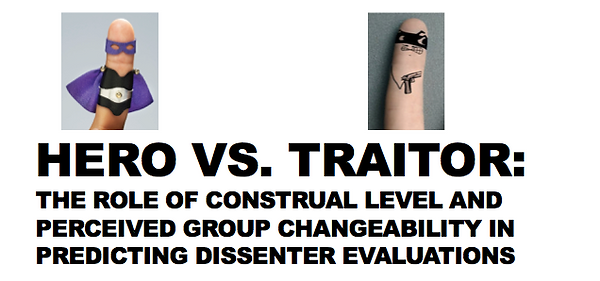Although now considered as heroes, Galileo, Socrates, and Jeanne d’Arc were rather controversial figures to many people at the time. They were heroes to some for pointing out flaws of the current system, while others considered them as traitors for disturbing the status quo. When does a person become a hero or a traitor? This project tried to identify psychological factors that trigger members of a group to positively or negatively evaluate a dissenter who points out flaws of their own group. To answer the question, I designed multiple theory-based experiments.
Dissenter Evaluation

Hypotheses
Based on previous research, I posited that perceivers’ reactions to an ingroup member who dissents against a potentially harmful group norm depend on whether they are motivated by shorter-term group stability goals vs. longer-term group change goals. Specifically, they may negatively evaluate a dissenter for disrupting group stability in the present, or positively evaluate the dissenter for pursuing future group improvement. Higher perceived group changeability accentuates this goal conflict by making the dissenter’s group-change goal seem attainable.
Study Design / Data Collection
I ran experiments where I varied construal level, a cognitive factor known to shift goal selection from stability (low-level) to change (high-level), and perceived group changeability and then measured people’s evaluation of the dissenter.
All participants in these studies were college students from the psychology department participant pool. Participants were randomly assigned to high- or low-level construal condition, where they performed tasks that are known to shift construal level. After the construal manipulation, they received an ostensible college news article about plagiarism that introduced the group norm and the dissenter. The group changeability manipulation was embedded at the end of the news article. Once participants from both studies finished reading the article, they evaluated the dissenter and completed a manipulation check and school identification measure.
Data Analysis
Using SPSS, I first made sure the manipulations worked by running t-tests on manipulation check questions I embedded within studies. Once manipulations were validated, I ran ANOVA and/or linear regression analysis predicting the dissenter evaluation from the group changeability, construal level, and their interaction.
Findings
As predicted, individuals under high-level construal, and thus focused on longer-term group change goals, evaluated a dissenter more positively than individuals under low-level, when they perceive high group changeability.
Outcome
Presentations: I gave multiple 45 to 90-minute talks during lab and departmental meetings at OSU. This project was also presented at the Society for Personality and Social Psychology annual conference as a poster presentation.
Select Material – Click to Download